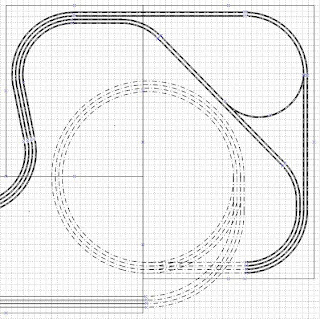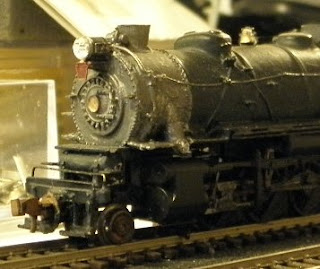 |
| PRR Class T1 4-4-4-4 Duplex |
No, this is not a dissertation on ichthyology. It's a dissertation on the peculiar product of the
Baldwin Locomotive Works that have come to be known as "
Sharks". The Pennsylvania was home to more of these rakish looking cab units than any other railroad. The
PRR not only owned more of them than anyone else, they helped design them. They also owned every model of the shark nosed diesels Baldwin built.
Raymond Loewy was involved in the styling and adapted the shape of the class
T1 duplex (4-4-4-4) steam locomotives to the diesel cab.
 |
| Baldwin DR-6-4-20 "Babyface" |
The earliest cab units with the shark-nose design were Baldwin's model
DR-6-4-2000. These locomotives were originally designed with
"baby face" cabs. In 1947, however, the Pennsylvania Railroad ordered 27 units in 9 A-B-A sets. The PRR had Loewy restyle the looks while the engineering staff redesigned the mechanicals. The result was one of the most unique diesel units ever built. Only the PRR owned the shark nose version.
 |
| PRR Class BP20 "Shark" |
They were not only distinctive looking they were huge. Eighty feet long, they weighed 385,000 pounds. When delivered in 1948 they sported a one of a kind DGLE paint scheme with five gold side stripes terminating in a circle surrounding a
gold and tuscan PRR logo. The lower of the dual headlights would disappear and the five stripes extended to the pilot in the "cat whisker" design used on other passenger diesels. The last A-B-A set purchased by the Pennsy were the last DR-6-4-2000 units ever produced. It was not, however, the end for the Loewy styled cab unit.
 |
| PRR Class BF15 "Shark" |
Baldwin built it's first
DR-4-4-1500, another model using the "baby face" cab. The original units were an A-B-A set built for the
Central Railroad of New Jersey. Subsequent units went to the CNJ,
Missouri Pacific and
New York Central which all ordered small lots of the 1500 HP diesel. In 1948 the Pennsylvania placed an order for 52 units in 26 A-B sets. The PRR units bore little resemblance to the previous DR-4-4-1500. Once again Pennsy redesigned the body and mechanicals. They also placed a follow up order in 1949 for another eight A-B sets. These units were painted much the same as the DR-6-4-2000 passenger diesels, DLGE with gold stripes and the keystone in a circle logo. This livery is unique to Pennsy sharks and was not used on any of the other Pennsylvania cab units.
 |
| PRR Class BF15a "Shark" |
When the PRR purchased another eight A-B sets in 1950, some changes were made. The locomotives were lengthened slightly and the intake louvers were removed in favor of panel filters. The cabs on these units were pushed forward 12" to make room in the engine compartment. The extra foot was taken from the nose section, resulting in what I would refer to as a "snub-nosed shark". Although nearly identical to their sister locomotives, Pennsy standards required a different classification for the modifications resulting in class BF15a. The short nose of the modified DR-4-4-1500 became the standard on all subsequent production sharks.
 |
| PRR Class BF16 "Shark" |
There were several more "generations" of sharks on the Pennsylvania. In late 1950 Baldwin increased the available horsepower to compete with Alco and Fairbanks-Morse. These 1600 HP units were designated RF-16 and were the most popular of the shark bodied diesels. The Pennsy ordered 60, 44 A units and 16 B units in August 1950. Another 42 units, 28 A's and 14 B's, were purchased in the spring of 1951. All told, the PRR owned 102 by the end of production in 1954.
Baltimore & Ohio and New York Central purchased the rest of the 160 units produced.
 |
| PRR Class ABF18 |
The last incarnations of the sharks were modified Pennsy units. Two of the BF16's were wrecked and rebuilt in 1959. These locomotives were re-powered with 1800 HP Alco prime movers. One of the DR-4-4-1500 B units was repowered in a similar manner after a wreck in the same year. These units were reclassified as ABF18. Most of these units were retired in the mid 1960's and sold for scrap.
Several of the DR-6-4-2000 passenger units (class BP20) were regeared and "detuned" to 1600 HP for freight service as class BF16z in 1952.
 |
| PRR # 9632B the Last "Shark" |
The last Pennsylvania shark to survive was this ABF18 B unit converted to a portable power station. In some final ignominy it was mounted on truck axles to power an electric shovel at a colliery in West Pittston, PA. The "experiment" never worked and it was ultimately scrapped sometime after 1991.
None of the Pennsylvania "sharks" survived the torch, but two of the New York Central units traded hands a number of times and still exist. They are believed to be stored on the
Escasnaba & Lake Superior in upper Michigan, locked away from public access after being vandalized. It's rumored that several parties have expressed an interest in restoration but the E&LS management ignores all inquiries.























